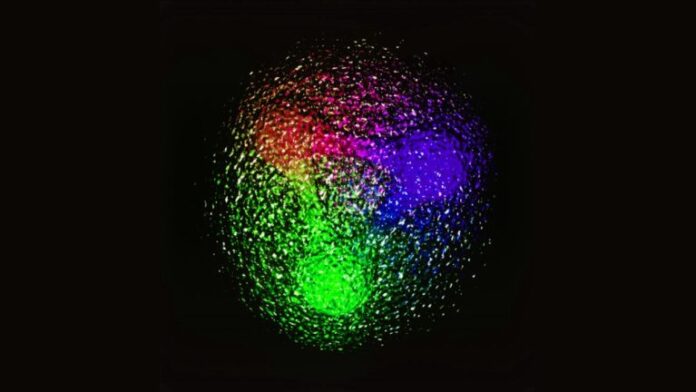Protons – It’s long been thought that protons are the heaviest particles in an atom. But new research is suggesting that they might be a lot more flexible than we thought.
Scientists have known for some time that protons have a strange property called “proton spin.” This means that they can exist in one of two states, spin up or spin down. But what was not known is whether or not protons can change their spin state.
Now, new research from the University of Manchester has shown that protons might be a lot more flexible than we thought. The researchers used a special machine called a spin-exchange optical pumping system to investigate the spin states of protons.
What they found is that protons can indeed change their spin state. This means that they are not as “heavy” as we thought they were. In fact, they are more like light particles than we thought.
This new research could have implications for our understanding of physics, this was originally thought to be impossible, but new research has shown that it is possible. The finding could have major implications for the field of quantum computing.
1. Introduce the concept of quarks and how they move within particles.
Quarks are the fundamental particles that make up protons and neutrons. They are also found in other particles such as mesons and baryons. Quarks are held together by the strong force, which is one of the four fundamental forces of nature. The strong force is responsible for the strong nuclear force, which holds nuclei together. Quarks are never found alone, they are always found in combinations of two or three.
There are six different types, or “flavors”, of quarks: up, down, strange, charm, top, and bottom. The up-and-down quarks are the most common and make up the protons and neutrons in an atom’s nucleus. The strange, charm, top, and bottom quarks are less common and are only found in larger particles. All of the quarks have a charge of +2/3 or -1/3. Protons are made up of two up quarks and one down quark, while neutrons are made up of one up quark and two down quarks.
The strong force that holds quarks together is extremely strong. It is about one hundred times stronger than the electromagnetic force. The strong force is also very short-ranged, which means that it only affects particles that are close together. Quarks are held together by gluons, which are particles that carry a strong force. Gluons are also held together by a strong force.
The strong force is responsible for the strong nuclear force, which holds nuclei together. The strong nuclear force is a residual force, which means that it is a leftover force from the strong force that holds quarks.
Quarks are a type of elementary particle that are classified as fermions, meaning they have half-integer spin. They are the fundamental building blocks of hadrons, which are composite particles made up of quarks. The best-known hadrons are the proton and neutron, which each contain three quarks. Quarks are also the building blocks of mesons, which are composite particles made up of one quark and one antiquark.
Mesons are produced when a high-energy hadron collides with another hadron. In particle accelerators, such as the Large Hadron Collider, mesons are produced when protons collide at high energies.Mesons are unstable and decay quickly into other particles. The most common decay products are electrons, positrons, and photons.
2. Explain how the electric field affects quarks.
Quarks are constantly in motion, and they can change their type by emitting or absorbing certain kinds of particles. The electric field affects quarks in two ways: it can either cause them to experience a force or it can change their energy levels.
Quarks are not the only particles that are affected by the electric field. Electrons, protons, and neutrons are also affected by the electric field. The electric field is a fundamental force of nature, and it plays a role in many of the interactions that occur in the universe.
The strong force affects quarks in a similar way, but it is much stronger than the electric force. The strong force is responsible for binding quarks together to form protons and neutrons.
The weak force is responsible for radioactive decay. It can cause quarks to change their types, which alters the type of particle that they are combined with to form a new particle.
The electric field can provide a force that repels or attracts quarks. This force is determined by the charge of the quarks. If the quarks have the same charge, then they will be repelled by the electric field. If the quarks have opposite charges, then they will be attracted to each other. The force between the quarks is also affected by the distance between them. The closer the quarks are, the stronger the force will be.
The electric field can also provide potential energy that the quarks can use to move around. This potential energy is determined by the charge of the quarks.
3. Discuss the implications of quark movement on the structure of particles.
Quarks are the elementary particles that make up protons and neutrons, and they are held together by a strong force. The force is transmitted by particles called gluons. Quarks also interact with each other via the electroweak force, which is transmitted by the W and Z bosons. The discovery of quarks has had implications for our understanding of the structure of particles.
Quarks are constantly in motion, and this movement has implications for the structure of particles. For example, the movement of quarks affects the way that protons and neutrons are held together. The stronger the force that holds the quarks together, the more stable the particle will be.
The discovery of quarks has also had implications for our understanding of the strong force. The strong force is transmitted by particles called gluons. Quarks interact with each other via a strong force, and the strength of this force depends on the number of quarks that are involved. The more quarks that are involved, the stronger the force will be.
The discovery of quarks has also had implications for our understanding of the electroweak force. The electroweak force is transmitted by the W and Z bosons. Quarks interact with each other via the electroweak force.
The discovery of quarks has led to the development of a new theory of the strong force, called quantum chromodynamics (QCD). In QCD, the strong force is transmitted by particles called gluons. Quarks interact with each other via the strong force.
The discovery of quarks has also had implications for our understanding of the weak force. The weak force is transmitted by the W and Z bosons. Quarks interact with each other via the weak force.
The discovery of quarks has led to the development of a new theory of the electromagnetic force, called quantum electrodynamics (QED). In QED, the electromagnetic force is transmitted by particles called photons. Quarks interact with each other via the electromagnetic force.
The discovery of quarks has had implications for our understanding of the strong force, the weak force, and the electromagnetic force.
Conclusion:
Subatomic particles are made up of smaller particles known as quarks that are held together by a strong connection known as the strong force. New studies appear to reveal that quarks respond more than predicted to an electric field pushing on them, according to physicist Nikolaos Sparveris and colleagues in Nature on October 19. The result implies that the strong force is not as powerful as the theory expects.
If the strong force is weaker than what has been predicted, what does that mean for the subatomic particles that are built of quarks?
Subatomic particles are tiny particles that make up the atoms that make up everything in the universe. The term “subatomic” means “below the atomic level.” The three main subatomic particles are protons, neutrons, and electrons. Protons and neutrons are made up of even smaller particles called quarks.
It is not yet clear what implications a weaker strong force would have on subatomic particles. However, it is possible that a weaker strong force could lead to a greater understanding of the strong force and how it works.
According to Pascalutsa, a different sort of experiment in science might make stretchable protons more appealing. A new research from the Paul Scherrer Institute in Villigen, Switzerland, might help. It will utilize hydrogen atoms with muons instead of the electrons that normally orbit the nuclei of atoms. Muons are around 200 times heavier than electrons and orbit far closer to the nucleus of an atom than electrons, providing a better view of the proton within (SN: 10/5/17). The experiment would include using lasers to stimulate the “muonic hydrogen” rather than scattering other electrons or positrons from it.
“The precision in muonic hydrogen tests will be significantly higher than in scattering experiments,” Pascalutsa claims. If the stretchiness appears, “then I would start looking at this straight immediately.”
Other areas of research that could be looked at about this are:
1) How muonic hydrogen could be used to improve the precision of experiments.
2) If the stretchiness of muonic hydrogen is indicative of a new physical phenomenon.
3) What other implications the discovery of muonic hydrogen’s stretchiness could have.
4) How this research could lead to new insights into the nature of our Universe.
How muonic hydrogen could be used to improve the precision of experiments Muonic hydrogen could also be used to improve the accuracy of calculated results from these experiments. By providing a more precise value for the size of the proton, muonic hydrogen could help to resolve discrepancies between experimental results and theoretical predictions. Additionally, muonic hydrogen could be used to study the strong force in greater detail,
which could lead to a better understanding of how our universe works at its most fundamental level.
If the stretchiness of muonic hydrogen is indicative of a new physical phenomenon Other possible implications of the new physical phenomenon could be changes in the way we conceive of space and time. The current understanding of these concepts could be challenged by the new discovery. Additionally, the new physical phenomenon could have applications in other areas of science, such as quantum mechanics.





